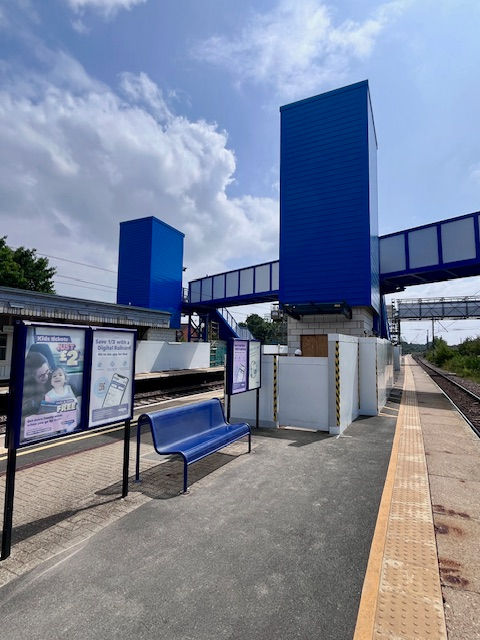White Lines (Don’t Do it) feat. Central Beds Council
- Julian Vaughan

- Mar 27, 2024
- 7 min read
From recent evidence, it seems that Central Bedfordshire Council views road markings as a ‘nice to have’, rather than a vital aspect of road safety. This blog sets how I believe they are misinterpreting research in this area and how their current approach reduces the safety of the roads across Central Bedfordshire.
I first raised the issue of Central Bedfordshire Council’s new policy regarding white-lining roads back in January 2017 in relation to Edworth Road. For those not local to the area, Edworth Road runs from the A1 by the water tower on top of Topler’s Hill, which is a prominent landmark heading Northbound through Bedfordshire, to the village of Langford, a distance of about 1.5 miles.

Edworth Road looking West – March 2024
Before resurfacing took place in 2016 the whole length of the road had white centre lines. After this resurfacing the white lines were not re-instated.
Initially, I queried this with the Council via Facebook messenger and received a response back as follows: “Our Highways team have said they took the decision to reassess the white lining layout while the repair work was being carried out. It was determined that this location would benefit from reducing the amount of lining, from a safety point of view. In this type of area, excessive lining can give an unhelpful impression of the road being dominant which can lead to increased speeds and conflict with other road users.“
Not satisfied with this response I did some research and found the ‘Traffic Signs Manual’ (Chapter 5) 2003* that states (my emphasis in yellow):
VISIBILITY
1.10 For road markings to be effective, they must be clearly visible both by day and by night. Markings have two principal functions. The first is symbolic, e.g. hatched markings; the driver needs to have learned that these indicate an area which is not available to traffic. The second is guidance; centre lines, edge lines and lane lines help drivers to maintain their lateral position on the road. Some markings, e.g. hazard lines and double white line systems have both symbolic and guidance functions.
1.11 The guidance function is less critical (although still important) in daylight or on lit roads because there are many visual cues available to enable the driver to judge course and position. On unlit roads at night, conditions are very different; the visual stimuli in the distance and to the sides of the road are largely absent. Road markings then become the most important aid in enabling the driver to follow the road.
The Traffic Signs Manual goes on to say that on rural roads less than 5.5m wide overrunning of the carriageway edge can occur if centre lines are provided. Having measured the width of Edworth Road this does not apply as the width of the road is approximately 6 metres.
*I have checked the most up to date Traffic Signs Manual, published in 2018, to see if this advice has changed. The section above is exactly the same.
I then wrote to Central Bedfordshire Council setting out the above and stating that I believed their decision safety to remove the centre lines based on safety was incorrect.
I suspected that their decision was taken on the basis of trials of white line removal at some locations across the UK and there had been a general move to reduce street signage and road markings in urban areas to reduce clutter and potential confusion. An example of this is Transport for London which published a report in 2014 which contained the results of trials of centre line removal.
I pointed out that these trials were conducted on urban roads with a speed limit of 30 mph and should not be used as justification for centre line removal on rural national speed limit roads.
I then received a reply back from the Leader of the Council. This reply repeated the justification of the first reply stating:
“Following recent studies on safer roads (post 2003), there is a body of evidence that suggests that the more you delineate a road the faster traffic drives and can create a situation that things like white lines lead to more accidents rather than fewer. Our officers and I believe a review involving our Sustainable Communities Overview and Scrutiny Committee, took the view that for rural roads we would adopt a policy of white lines only at junctions, or where there were visibility issues such as on a winding section or brow of a hill. I am unaware of the specifics of the road you mention, so cannot comment if it meets the above.“ Cllr James Jamieson former Leader Central Beds Council – February 2017
I then replied back stating that other centre line removal trails such as those that took place in Wiltshire did so on roads that had street lighting, which clearly is absent from Edworth Road.

Edworth Road looking East towards the water tower
At some point after these exchanges with the Council (and I am aware others were also pressing them on this issue) they partially relented and white-lined two small sections of the road at the water tower (A1) end and also approaching the humpback bridge that goes over the railway line (Langford end). In 2020 I was contacted by the Langford Parish Council who asked if I could forward them the previous correspondence I had with Central Bedfordshire Council, which I was happy to do. I know that local Councillors are still pressing for white lines to be installed along the entire stretch and that the issue has been raised with our local MP.
Having lived in Langford since 2006 and also doing shiftwork in London I often drive up this road in the dark, so I am aware that it is often affected by mist and fog. I am also aware of the substantial increase in traffic on this road since 2016 due to significant housing development in Langford and the surrounding villages. While I do not have any qualifications in traffic management, I have previously been a Driving Instructor so I have considerable experience in driver behaviours. As I reported to the council, I had seen a significant change in how drivers positioned themselves on the road in the absence of the white lines.
So what is this evidence that the Council keeps quoting as justification for not white-lining significant sections of their highways?
Wiltshire Council – 2002
This article from 2003 https://www.gazetteandherald.co.uk/news/7327095.white-line-removal-cuts-traffic-accidents/ discusses Wiltshire Council’s removal of white lines from the centre of 12 roads in Wiltshire. As I mentioned earlier it should be noted that all these roads had street lighting and also had a 30 mph speed limit in place.
*Interestingly, Wiltshire Council seems to have had undertaken a complete about turn on this issue as a post from their website in November 2022 talks about their plans to invest an extra £200,000 each year on white line painting in their area, with their Cabinet Member for Transport, stating: “We know from speaking to our communities that maintenance such as white line painting really makes a difference to the appearance of our highways, and of course more importantly it improves safety too”.
Transport for London – 2014
The Transport for London trial details can be found here: https://tfl.gov.uk/corporate/transparency/freedom-of-information/foi-request-detail?referenceId=FOI-1184-1920 Again, the areas trialled were in 30 mph speed limit areas and also had street lighting. The report did find, like the Wiltshire Council trial, that speeds were reduced, but interestingly the conclusion of the report warned:
“It is important to note that not all roads would be suitable for removing central markings, particularly where the markings highlight a particular hazard. If the technique is being considered, careful analysis of the site will be required to determine if it is appropriate.” TfL Centre Line Removal Trial 2014
Manual for Streets – 2007
The Department for Transport’s ‘Manual for Streets’ https://assets.publishing.service.gov.uk/media/6270d4838fa8f57a360f8b91/Essex_Manual_for_Streets_Redacted.pdf also talks (p118) about the removal of white centre lines. However, yet against uses examples of urban areas with 30 mph speed limits.
So it would seem that Central Bedfordshire Council are justifying their approach to their lack of white lining on unlit rural roads by using data from trials undertaken on 30 mph roads in urban areas with street lighting. Clearly, these totally different road environments are not comparable.
So how does Central Bedfordshire Council approach reports of defective road markings? The B659 road between Biggleswade and Langford is an unlit 60 mph speed limit road with moderate bends. I had noticed that at these bends (and along most of the road) the road studs were defective and the white centre line at the second bend and at the junction with Southill Road was worn so badly that it is virtually invisible. The Council’s response to my reports, I sent in two reports via ‘Fix my Street’ on 20th November 2023 and 16th February 2024, was that they had “inspected the defect and that no planned repair is necessary at this stage”. Take a look at dashcam footage of this stretch of road and see what you think.
Dashcam footage Biggleswade to Langford Southbound – 25th March 2024
With car safety systems such as lane departure warning systems, reliant on white centre lines, becoming more common, it makes the Council’s decision to “adopt a policy of white lines only at junctions, or where there were visibility issues such as on a winding section or brow of a hill” even more strange.
Therefore, it seems we can only come to the conclusion that the council used the data from trails in well-lit urban areas and mistakingly used it as justification for the removal of white lines on our rural roads as a means to save money.
How much do road improvements cost?
With thanks to Wiltshire Council, an example of the costs for various road improvements is shown below.
White lining costs up to £8.50 per metre. Hatching costs approximately £15 per metre squared. Removal of white lines costs £25 per metre. Road studs cost an average £25 each. + (£2,000 establishment cost) Traffic management is additional to these costs.
A full list of the costs of various highway works (in Wiltshire) can be found here (2022 prices); https://www.wiltshire.gov.uk/article/1281/Costs-of-highway-works
Conclusion
Around 60% of the people killed in road accidents in the UK are killed on rural roads. We should be doing all we can to ensure roads are as safe as they can be. The decision to cut back on centre line markings was taken under a previous administration. I urge the new leadership of Central Bedfordshire Council to change their mind, not just about Edworth Road but also about the misguided policy of their predecessors and to be proactive rather than reactive in relation to road safety.
This blog was forwarded to the current Leader of Central Bedfordshire Council on 27th March for comment.
Julian Vaughan
26th March 2024
Further Reading
UK Reported Road Casualties 2022: https://www.gov.uk/government/statistics/reported-road-casualties-great-britain-annual-report-2022/reported-road-casualties-great-britain-annual-report-2022#:~:text=In%202022%2C%2044%25%20of%20fatalities,showed%20a%20decline%20of%209%25
UK Crash Map: https://www.crashmap.co.uk/Search
Central Bedfordshire Council – Personal Injury Claim: https://www.centralbedfordshire.gov.uk/info/55/transport_roads_and_parking/595/highways_team_-_what_we_do_information_and_news/4
Traffic Signs Manual (Chapter 5) Road Markings: https://assets.publishing.service.gov.uk/media/5c4ace6ded915d38a0611abc/traffic-signs-manual-chapter-05.pdf
Highways – The New Code of Practice – Practical Thoughts for Litigation: https://www.farrarsbuilding.co.uk/highways-the-new-code-of-practice-practical-thoughts-for-litigation-by-martin-ferguson/
The Highway Code: https://www.gov.uk/guidance/the-highway-code






Comments